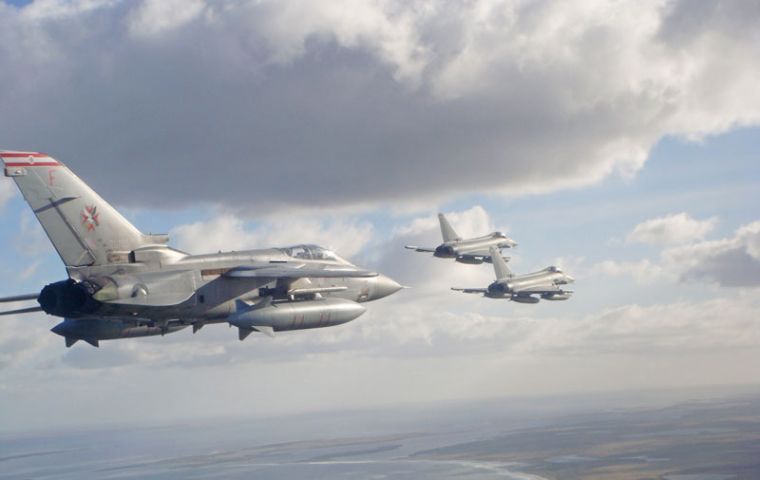MercoPress. South Atlantic News Agency
UK contingency plans to ensure no outside disruptions of Falklands’ March referendum
 According to The Telegraph, additional troops, another warship and extra RAF Typhoon combat aircraft could be dispatched
According to The Telegraph, additional troops, another warship and extra RAF Typhoon combat aircraft could be dispatched The United Kingdom defence chiefs have drawn up new contingency plans designed to prevent hostile action by Argentina towards the Falkland Islands, ahead, during or after the March referendum, according to reports presented by English newspaper The Telegraph.
“A series of military options are being actively considered as the war of words over the Islands intensifies”, the tabloid published on its Sunday’s edition.
It is understood that additional troops, another warship and extra RAF Typhoon combat aircraft could be dispatched to the region ahead of the March referendum on the Falklands’ future.
The options being proposed by planners at the Permanent Joint Headquarters in Northwood, north-west London are also said to include a “show of force” such as conducting naval exercises in the South Atlantic.
These could involve the deployment of the Royal Navy’s Response Task Force Group, a flotilla comprising destroyers, a frigate, a submarine and commandos.
Alternatives include deploying elements of the Army’s 16 Air Assault Brigade, the airborne task force which includes members of the Parachute Regiment and that has just completed a series of demanding exercises in Spain preparing for “general war”.
The Falklands government is expecting an overwhelming majority “yes” vote when the Islanders are asked on March 11: “Do you wish the Falkland Islands to retain their current political status as an Overseas Territory of the United Kingdom?”
Intelligence chiefs have warned David Cameron that a resounding “Yes” vote could lead to an aggressive “stunt” by the Argentine government, such as the planting of the country’s flag on one of the many islands by a small raiding party.
Other possibilities include a “cod war” style harassment campaign by the Argentine navy of the Falklands’ fishing fleet and the disruption of British oil and gas exploration. Such a move, officers have warned, could quite quickly escalate into aggressive action if the Royal Navy was ordered to intervene.
Senior sources emphasized that in drawing up the contingency plans they were acting out of prudence so that nothing would take them by surprise.
A senior defence source told The Telegraph: “Britain needs to be in a situation to respond very quickly to a whole series of threats, which is why we have contingency plans. Our posture has not changed but neither are we complacent.
“There are a number of contingencies to deal with any threat to the Falklands and they are currently being reviewed. No orders have been given to any military unit at this stage but prudent planning within all units who could be deployed in the event of a crisis is taking place.
“That is quite normal. Commanders like to be two steps ahead rather than two steps behind.”
Around 1.500 troops are permanently based on the islands, along with four RAF Typhoon jets and anti-aircraft and artillery batteries and land to air missiles.
A Royal Navy destroyer, currently HMS Edinburgh, is always on duty in the South Atlantic, working alongside the patrol ship HMS Clyde, the fleet tanker HMS Gold and the ice patrol ship HMS Protector.
One of the Royal Navy’s nuclear powered submarines is always on notice to move to the region if the diplomatic situation deteriorates.
Last year HMS Dauntless, a Type 45 destroyer and one of the Royal Navy’s most capable vessels was dispatched to the South Atlantic during the 30th commemoration of the war.
Despite the increasing hostile rhetoric from Argentine president Cristina Kirchner, the British government believes that Buenos Aries currently lacks both the political will and military capability to recapture the islands.
But the Prime Minister has told his cabinet and senior defence chiefs that Britain should not be complacent and must be fully prepared for every eventuality.
The Telegraph finally compares UK’s current military forces with 1982:
1982: Armed Forces Personnel: 320,000; Ships: 2 Carriers, 2 Assault ships, 32 Submarines, 15 Destroyers, 46 Frigates, 1 Ice Patrol Ship, 12 Hydrographic survey ships, 15 Patrol ships/craft, 29 Minesweepers and mine-hunters, 45 Royal Fleet Auxiliary and 400 plus aircraft.
2013: Armed Forces personnel:160.000; Ships: 0 Carriers, 9 Submarines, 7 Destroyers, 13 Frigates, 2 Assault/Helicopter Carriers, 2 Assault/Command Ships, 3 RFA Landing Ships, 3 Survey ships, 1 Ice Patrol Ship, 4 Patrol Ships, 15 Mine-hunters, 10 Royal Fleet Auxiliary. Fighter Aircraft: 130.




Top Comments
Disclaimer & comment rules-

-

-

Read all commentsOh dear god!! just wait for the outraged screams and hissy fits from BA. “They're invading our islands, they're invading our islands!!”
Jan 14th, 2013 - 07:11 am 0“The English are coming!!!”
Wah, wah, wah!!!!!
Note to KFC:- You do know the islands are British, right?
I'm wondering if the UK has evidence that this is a realistic threat? They uncovered a plot by Argie fishermen to be morons not so long ago and scuppered that, I wonder what info the UK has that would necessitate this?
Jan 14th, 2013 - 07:26 am 0News Headline: Military Planners Actually Plan Things...
Jan 14th, 2013 - 08:00 am 0Good thing too, it is what we pay them for after all.
Commenting for this story is now closed.
If you have a Facebook account, become a fan and comment on our Facebook Page!